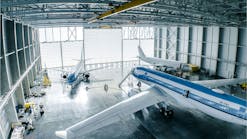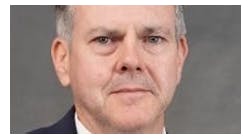Guaranteed Engine Maintenance Programs
Boon or Boondoggle
By Bill de Decker
October 1998
Bill de Decker is a Partner with Conklin & de Decker Associates, publishers of aircraft operating cost databases, MxManager® integrated maintenance management software, and consultants on cost analysis and fleet planning. He has over 35 years experience in fixed and rotary wing design, marketing, training, operation, and management. He also teaches a number of aviation management courses.
They are known by names such as "ESP," "MSP," "JSSI Complete," and "Power-by-the-Hour," yet they all have one thing in common — comprehensive turbine engine maintenance and overhaul coverage at a fixed price per hour.
This coverage is now offered by almost all of the major turbine engine manufacturers, as well as one independent company. They are available for almost all engines in common use on helicopters, turboprops, and jets.
These programs generate a lot of heated debate. Some people believe they can get their engine maintenance for a lot less money than to buy into a program — others are convinced that it is the best thing since sliced bread; and still others support a full range of opinions in between.
What is without debate is that these maintenance plans have become quite popular. What is also without debate is, that as managers, we have to take a step back and look at these programs from a management point of view. Perceptions aside, the real questions you must answer are:
• How do the costs compare?
• What are the benefits of these programs?
• How can this help your organization?
First, lets look at the costs. This is where a lot of the confusion gets started, because many people think the maintenance cost of the engine is the same as the hot section inspection and overhaul cost. For one popular engine, the cost of the hot section inspection and overhaul is about $71.50 per hour, while the guaranteed maintenance cost is about $110 per hour.
One possible conclusion is that the company providing the guaranteed maintenance program is making one heck of a profit! Although these programs come in many different flavors, the most popular ones (including the one in the previous example), are the comprehensive ones. These include a lot more than just hot section inspections and overhauls. They also include consumables, maintenance of the accessories, recommended and mandatory service bulletins, loaner engines, coverage for premature removals, unscheduled maintenance, and replacement of life limited parts.
If each of these additional coverage items is priced out, it increases the cost per hour from $71.50 to $114.50 and all of a sudden, the guaranteed maintenance charge of $110 per hour looks pretty reasonable!
Second, let's look at the benefits. The major ones are:
• Guaranteed maintenance plans take the uncertainty and unpredictability out of one of the major cost areas on any aircraft. Engine maintenance costs are nearly negligible until heavy scheduled or unscheduled maintenance is required. For example, a typical overhaul on a small jet may cost $200,000 per engine. If that small jet is used in charter service, it may generate about $1,000,000 in charter revenue for a year. Overhaul of two engines will be about $400,000, or 40 percent of the revenues for that aircraft for the year.
If the year hasn't been all that good, this will be a nightmare for the chief financial officer. At the same time, it distorts the financial picture — the years prior to the overhaul will show a higher profit than was warranted, and the year with the overhaul will show a huge loss.
Thus, from both a cash flow and a financial management point of view, it is in fact much better to spend a fixed hourly fee for each hour flown and avoid the huge expense peaks associated with paying for heavy maintenance as incurred. This applies whether you are with a small charter operation or with the corporate aviation department of a Fortune 500 company — both watch cash flow like hawks.
• Aircraft brokers will tell you that it is easier to sell an aircraft that is on a guaranteed engine maintenance program. In addition, the aircraft will bring a higher price. For example, the Aircraft Blue Book valuation of used aircraft with AlliedSignal engines is based on the engines being on "MSP," the AlliedSignal guaranteed engine maintenance program. If the engines are not on "MSP," the valuation is reduced by the number of engine hours multiplied by the MSP rate. Aircraft with other engines that are on a guaranteed engine maintenance program get treated in a similar manner. In other words, you get the unused portion of the money spent on guaranteed engine maintenance programs back in the selling price of the aircraft.
• You get support when you need it most — such as when you need loaner engines, or you have had an unscheduled engine removal. Part of most guaranteed maintenance agreements is that loaner engines will be provided at no charge when your engine(s) are off the aircraft for repair or heavy maintenance. The companies providing guaranteed maintenance programs have significant pools of spare engines to provide this support. Also, the time after an engine has had an unscheduled failure is not the time to have to become an expert on deciding the best way to get the aircraft back in the air. With a guaranteed maintenance program, that expertise is one phone call away. And best of all, the advice and the repairs are all included in the hourly fee.
So, how can these guaranteed maintenance programs help your company? First, it makes budgeting and cash flow management much easier. Financial types really dislike huge expenditures of a variable size that occur on an infrequent basis. They dislike these because it makes their financial planning very difficult.
Second, guaranteed engine maintenance programs, by requiring pay-as-you-go monthly payments, give a much more realistic picture of the cost of operation of your aircraft and, if you are a commercial operator, a more realistic picture of your profitability. Remember, if you pay for engine heavy maintenance as incurred, you will be understating the real cost of operation for most years and overstating it in the year when the heavy maintenance is done.
Third, it is like an insurance policy that covers unexpected expenses such as expensive mandatory service bulletins and premature engine removals.
As a manager, these are powerful arguments in favor of guaranteed maintenance programs. After all, one of the important tasks of department managers is to provide as much operational and financial stability and predictability for their departments as possible. That doesn't mean that guaranteed engine maintenance is for everyone. It does mean that the advantages and disadvantages for your operation should be subjected to very careful scrutiny.
If you think that these programs are just for the "little" operators, keep in mind that within the last year, both the lowest cost major airline (Southwest), and one of the most innovative (American), have started switching to guaranteed maintenance contracts for the engines in their respective fleets.
Corporate Aviation Matters: Roundtable Discussion with Maintenance Managers
Corporate Aviation Matters
Roundtable Discussion with Maintenance Managers
October 1998
What keeps you awake on Sunday nights? In August, AMT met with ten maintenance management professionals and two aviation association affiliates and put that question on the table. What followed was a very lively and informative discussion regarding the critical issues facing corporate aviation and the industry as a whole.
JUDGMENT CALLS
Len Beauchemin, manager, Technical Support Aviation Services, for Eastman Kodak Co., Rochester, NY, answered first with concerns over how we educate technicians with relevance to judgment. He spoke of recurring incidents mentioned in maintenance alerts that involve judgment issues with regard to installations made and not following procedures. Beauchemin felt it (judgment) can be learned, but much is inherent, and that it must be addressed in the schools as well as on the job. He gave the example of his own education in A&P school where the focus was more on passing the test than on the implications of making errors in judgment when servicing aircraft. Exercising judgment, good, solid judgment in maintenance as well as understanding the implications of working with distractions, be it personal or professional issues that would hamper good judgment and could possibly produce safety hazards in the facility and for the aircraft.
"There's no environment, no paper work system that you can put into place," he explained, "that's going to eliminate an incident. We're in an environment where we can make a mistake that will not be detected prior to the aircraft leaving. It's possible, and what I drive in to my people constantly is to have an awareness of what their level of efficiency and focus is each day. If it isn't high enough, then tell their supervisor or tell their peer that they don't feel up to the level required."
Beauchemin also said that managers must help to manage the distractions at the facility for their employees. They may not always be aware of or able to aid with their employees' personal distractions, but they can go a long way to reduce and eliminate distractions in the workplace. His philosophy, "As a manager, I have to manage distractions constantly so they can focus on their jobs."
Larry Elliott, chief of maintenance, Aviation department at Johnson Controls Inc., in Milwaukee, WI stated that "Judgment is acquired by knowledge. Lack of structure, lack of standardization, and complacency are problems in corporate aviation."
Jon Haag, chief of maintenance with Philip Morris in Milwaukee, WI, interjected, "I think some of the judgment problems occur when they come out of school, and one thing that is not driven home is to use the manual. Some of the judgment calls can be taken right out of the system by following manuals — aircraft manuals, powerplant manuals, whatever, and it seems to be a real struggle to get people to, if they see something wrong, to go to the manuals, see what the criteria is, and follow those instructions."
Harry Cleis, chief of maintenance for Abbott Laboratories in Waukegan, IL, said manuals were a "hot button" item with him. "No flight maintenance training schools teach manufacturer maintenance manuals — they use [their own] training guides instead. These are not adequate and are not legal. Students are not being introduced to peculiarities with parts in maintenance manuals."
James West, manager, Technical Services, with Philip Morris Management Corp. in White Plains, NY, claimed that approved data is what you have to use; yet there are inconsistencies. He believes that students should be taught directly from maintenance manuals in an effort to improve those manuals and keep those texts consistent and current.
Quality Control
With regard to judgment in the manual versus memory issue, the group was asked about a formal quality control system that would be in place
at a Part 145 operation, for example, that is lacking in corporate aviation.
Haag responded "That's the problem, a memory problem. If you don't rely on your memory, and check the books first, you can eliminate a lot of problems. There are a lot of inspection requirements and criteria in the manuals."
A comment made about doing your own work and then inspecting your own work garnered a collective "That's not always the case."
West spoke up with "Size and shape of organization dictate what you can do, but we have selectively pulled things out of the basic 145 operations and have implemented those items into our own maintenance programs. Now, granted it's not mandated, and the organizational structure is not mandated like it would be for a repair station, but we do have policies in place that tell people that whenever possible, someone else will check your work; so that the person doing the work isn't responsible for checking the work. You can do things like that; and really I don't know whether it's necessary to try and emulate AC145, or if it's just common sense, but if you just think about the number of times, over and over, a person has done a job, and in fact, the more familiar they are with a job, the more likely they are to make a mistake."
Beauchemin added, "Problems with judgment arise from complacency in the everyday. "Complacency is our enemy."
West then pointed out, "Once you drill it into people's heads that getting their work inspected is a great way to brag about the quality of their work, then it almost becomes second nature for them on their own to call someone over. You can do those things if you start drilling it into their heads early, and make it part of their culture. It doesn't take a staff of 20 or a staff of 200, it can be done with a staff of 2."
Service Centers
Dale Hamilton, chief of maintenance for Harpo Inc. in Chicago, IL, brought up the problem of the one-person maintenance shop. He is that type of operation and has difficulty with checking and rechecking systems without the benefit of another set of eyes for inspections. He relies on service centers to inspect a good portion of his work, but feels as though he must "baby-sit" the airplane at the service facility for fear of quality of service.
This comment touched a nerve with everyone and the war stories of inept service centers were told Ôround the table. According to the group, service centers are reaching critical levels of knowledge deficiency and lack of expertise in the evaluation of aircraft.
Tim Bryant, chief of maintenance, SCI Management Corp. Aviation, in Houston, TX, spoke of having to spend time "babysitting" aircraft he takes to service centers because of his lack of confidence in their inspection and troubleshooting capabilities. He took three days at a particular facility to watch them every step of the way on an interior refurbishment. Fortunately, he was there the day the service center people were about to install the wrong amenities in his aircraft.
Haag responded with a proposal to hold service centers and manufacturers contractually accountable.
While many of the negative experiences shared about service centers mirrored one another, the group agreed that there were good service centers and that they would route their planes to those facilities. The concerns with the problematic facilities were not about cost, but more that the technicians at the service centers were inexperienced, and that there seemed to be lots of turnover with employees at the facilities.
Qualified Technicians
Paul Leddy, aircraft maintenance supervisor, with the Ford Air Transportation Office in Detroit, MI, said the thing that kept him awake on Sunday
nights was the lack of experienced people to choose from and the lack of responsibility given to the newest technician. Newer employees, even those with the lowest seniority, should have the same ability and the same self confidence as a senior technician to shut things down if they feel it necessary, and they need to know that they will be supported for their decisions. "Individuals going into this career need to elevate themselves," Leddy began. "Someone needs to tell them, whether it's the FAA, a magazine, or someone else that ÔYou are the one that says this aircraft is safe when it leaves the ground.' Too many new technicians are afraid of backlash from management and co-workers for voicing concerns. They need to know that they are the control factor."
Cleis commented on enhancing image of technicians — "buffoon" image needs to go. That image has been promoted for as long as there have been airplanes. "Any good maintenance department of any corporation, is absolutely invisible if they're doing their jobs right. Industry needs to promote better image and they need to pay Ôem. Nobody is going to want to come into this industry because of the low pay levels — these kids are too smart for that, they're just not going to do it"
West followed with questions as to what it takes to keep technicians as well as get technicians. Are career aspirations being addressed? Are we providing those opportunities?
John Link, director of maintenance/operations, American International Aviation Corp., Teterboro, NJ, proposed career "enrichment" rather than career ladder because of the narrowness of the structure of their type of operation.
West spoke of limited potential with respect to vertical growth and horizontal growth. "Horizontal can be worked on through training. Timely, objective feedback is necessary and important. It's the only way that a person understands what is expected of them."
Haag said, "Career enrichment is important. Corporations need to keep this in mind and promote the options and find the motivations of their staff."
Beauchemin followed with a discussion of the personal development programs in place at his organization designed to help staff. "Management needs to take ownership as well as do technicians for personal development."
On the Subject of Getting People
The contacting, acquiring, and hiring of qualified technicians has for most, reached its critical limit. The group tabled some explanations and proposed some suggestions.
Link pointed out that the military pools aren't there anymore to draw from.
Cleis added that A&Ps put out a personal investment of thousands of dollars for education and tools even before getting a job.
"What job do you know of that requires you to spend about $15,000 to $20,000 on education, and then have to show up first day with $10,000 worth of tools and equipment? Cleis also spoke of the incredible personal responsibility that goes with the territory of being an A&P.
Leddy likened it to being like farmers; industry needs to nurture young people at high schools and in the community to promote aviation maintenance as a viable and fulfilling career.
The Order of Things
Elliott then said, "Safety keeps him awake. Gaining respect through grounding planes when necessary." He then gave in order of importance, his concerns: safety, dispatch reliability, and cost of operations.
All agreed that cost came after safety.
Not being able to control maintenance budget was the big concern for Cleis.
John Bucher, chief of maintenance, Flight Operations, for Honeywell Inc., Minneapolis, MN, followed Cleis' concerns with the comment that "Flight operations has changed drastically since WWII. Now it has evolved into a department with budgets and reviews, but I think it's for the better."
Part 66
First, about the name changeÉ Haag thought the focus didn't necessarily
have to be on the name. "Call me a Doctor of Airplanes if you want."
Cleis felt it should have been AME, Aviation Maintenance Engineer, to standardize with Canada and Europe.
It was discussed that a name change would produce better pay and benefits. There were arguments pro and con about the AMT(T) certificate. No one seemed to want a two-tiered or class system as a result, but the bar should be raised enough to standardize across the board, to avoid a class system.
Cleis made the point about this new certification creating problems with hiring. He gave the example of "Do I hire the A&P who seems more competent, or, do I hire the AMT(T) because he/she has the certification?"
West said that the bar should be raised for all, not just for some in order to increase professionalism and quality.
As a follow-on comment, West stated that while he is not an advocate for government intervention, he raised the point that it's not by accident that FAA mandates pilot training, yet FAA does not mandate maintenance training. Why?
As the discussion became more heated with regard to Part 66, Fred Kirby, senior manager, Safety and Maintenance for NBAA, asked the group to keep in mind what the current rules say and do, and then look at how the proposed changes will affect those current rules. He then asked the group to remember that Part 66 is only a NPRM (notice of proposed rule making). It will be best served by those persons affected by it, to actively participate in the revision and composition of the final draft through submitting their comments to the representatives who will evaluate those comments, and then incorporate them into subsequent drafts of this new FAR. It is important to also remember that this is not a forum to only vent on a few points, but to analyze the total package and to remind those developing the proposal of the good things incorporated in the document. Feedback is very important to the successful execution of this regulation.
The industry is very concerned about the shortage of qualified technicians, but its impact is not necessarily being felt by the corporate operators. Finding qualified technicians at service centers was more of a distressing point for these managers — the costs associated with services from quality service facilities were not. Safety was a top priority, and if they had to pay more for peace of mind obtained by taking their aircraft to a facility that provides competent, efficient, and thorough service, so be it.
Aircraft Maintenance Technology would like to again thank all of the managers and association members for participating and sharing their concerns and comments at this meeting. These discussions, and those held in the future, can serve as a change agent for the industry in a positive way, when change is necessary.





